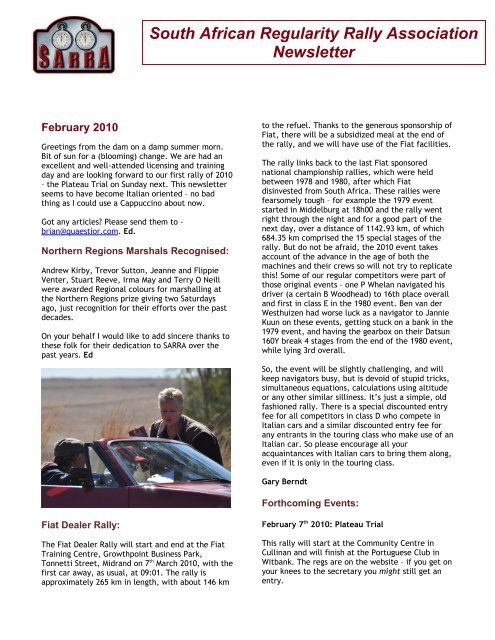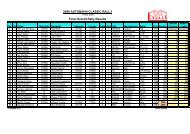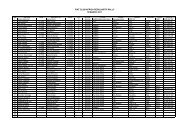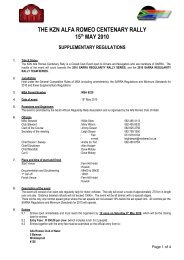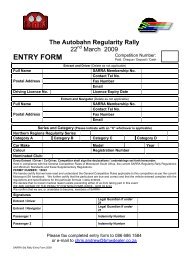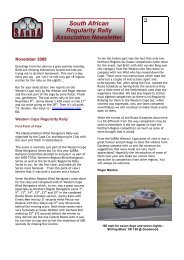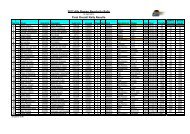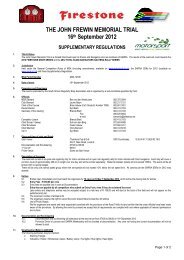Classic Regularity Rally - The South African Regularity Rally ...
Classic Regularity Rally - The South African Regularity Rally ...
Classic Regularity Rally - The South African Regularity Rally ...
You also want an ePaper? Increase the reach of your titles
YUMPU automatically turns print PDFs into web optimized ePapers that Google loves.
<strong>South</strong> <strong>African</strong> <strong>Regularity</strong> <strong>Rally</strong> Association<br />
Newsletter<br />
February 2010<br />
Greetings from the dam on a damp summer morn.<br />
Bit of sun for a (blooming) change. We are had an<br />
excellent and well-attended licensing and training<br />
day and are looking forward to our first rally of 2010<br />
– the Plateau Trial on Sunday next. This newsletter<br />
seems to have become Italian oriented – no bad<br />
thing as I could use a Cappuccino about now.<br />
Got any articles Please send them to -<br />
brian@quaestior.com. Ed.<br />
Northern Regions Marshals Recognised:<br />
Andrew Kirby, Trevor Sutton, Jeanne and Flippie<br />
Venter, Stuart Reeve, Irma May and Terry O Neill<br />
were awarded Regional colours for marshalling at<br />
the Northern Regions prize giving two Saturdays<br />
ago, just recognition for their efforts over the past<br />
decades.<br />
On your behalf I would like to add sincere thanks to<br />
these folk for their dedication to SARRA over the<br />
past years. Ed<br />
to the refuel. Thanks to the generous sponsorship of<br />
Fiat, there will be a subsidized meal at the end of<br />
the rally, and we will have use of the Fiat facilities.<br />
<strong>The</strong> rally links back to the last Fiat sponsored<br />
national championship rallies, which were held<br />
between 1978 and 1980, after which Fiat<br />
disinvested from <strong>South</strong> Africa. <strong>The</strong>se rallies were<br />
fearsomely tough – for example the 1979 event<br />
started in Middelburg at 18h00 and the rally went<br />
right through the night and for a good part of the<br />
next day, over a distance of 1142.93 km, of which<br />
684.35 km comprised the 15 special stages of the<br />
rally. But do not be afraid, the 2010 event takes<br />
account of the advance in the age of both the<br />
machines and their crews so will not try to replicate<br />
this! Some of our regular competitors were part of<br />
those original events – one P Whelan navigated his<br />
driver (a certain B Woodhead) to 16th place overall<br />
and first in class E in the 1980 event. Ben van der<br />
Westhuizen had worse luck as a navigator to Jannie<br />
Kuun on these events, getting stuck on a bank in the<br />
1979 event, and having the gearbox on their Datsun<br />
160Y break 4 stages from the end of the 1980 event,<br />
while lying 3rd overall.<br />
So, the event will be slightly challenging, and will<br />
keep navigators busy, but is devoid of stupid tricks,<br />
simultaneous equations, calculations using altitude<br />
or any other similar silliness. It’s just a simple, old<br />
fashioned rally. <strong>The</strong>re is a special discounted entry<br />
fee for all competitors in class D who compete in<br />
Italian cars and a similar discounted entry fee for<br />
any entrants in the touring class who make use of an<br />
Italian car. So please encourage all your<br />
acquaintances with Italian cars to bring them along,<br />
even if it is only in the touring class.<br />
Gary Berndt<br />
Forthcoming Events:<br />
Fiat Dealer <strong>Rally</strong>:<br />
<strong>The</strong> Fiat Dealer <strong>Rally</strong> will start and end at the Fiat<br />
Training Centre, Growthpoint Business Park,<br />
Tonnetti Street, Midrand on 7 th March 2010, with the<br />
first car away, as usual, at 09:01. <strong>The</strong> rally is<br />
approximately 265 km in length, with about 146 km<br />
February 7 th 2010: Plateau Trial<br />
This rally will start at the Community Centre in<br />
Cullinan and will finish at the Portuguese Club in<br />
Witbank. <strong>The</strong> regs are on the website – if you get on<br />
your knees to the secretary you might still get an<br />
entry.
March 7 th 2010: Fiat Club Africa <strong>Classic</strong> <strong>Regularity</strong><br />
<strong>Rally</strong><br />
This will start and end at the Fiat Training Centre,<br />
Growthpoint Business Park, Tonnetti Street,<br />
Midrand. Call Ian Huntly 082-650-0618 for details.<br />
Other Lives<br />
dismantled. On the left side of the courtyard, was<br />
the slightly smaller workshop that housed all the<br />
Lancia Stratos ‘works’ cars, and customer spec<br />
131’s. <strong>The</strong> team generally only used a chassis about<br />
6 times. First by the main drivers, then the<br />
secondary drivers, then it would usually be stripped<br />
out, and either sent over to the customer<br />
department to be sold of as a customer spec car, or<br />
to rust away at the back of the facility.<br />
Our Northern Regions Chairman otherwise<br />
occupied at Zwartkops<br />
Fiat 131 Abarth <strong>Rally</strong><br />
Three world championships, 1977/78 & 80, makes<br />
the Fiat 131 Abarth <strong>Rally</strong>e (to use its full title) one<br />
of the most successful and versatile world<br />
championship rally cars of all time. Capable of<br />
winning on tarmac, and on the roughest of dirt<br />
roads, the strength of these cars lay in the ease of<br />
adaptability, and their immense strength of the<br />
chassis.<br />
Almost all the outer panels were either fibreglass or<br />
aluminium (except the roof), the windows were<br />
Perspex, and there was absolutely nothing of the<br />
standard road car, that did not have to be there,<br />
yet given all that, the car still weighed close to 1<br />
100 kgs, in rough road trim, and 975 in light weight<br />
trim. Abarth went to town when they homologated<br />
this car – in fact they got it so right, that very few<br />
amendments were made over the next 4 years. 400<br />
body shells were made on the Fiat production line,<br />
350 were shipped to Bertone (the Italian coach<br />
building firm) for assembly as homologation road<br />
specials, the other 50 were sent to Abarth to be<br />
used as the works rally cars.<br />
This was a no expense spared operation. At the<br />
Abarth works, on the left side of the courtyard, was<br />
the large workshop building that housed usually,<br />
around 6 ‘works’ cars at any one time, and at least,<br />
10 other body shells either being built or<br />
<strong>The</strong> cars used ‘production’ cylinder blocks –<br />
Fiat/Lancia 1995 cc twin cam block. Abarth made<br />
extensive modifications to them before assembly.<br />
<strong>The</strong> heads were an Abarth designed and built twin<br />
cam 16 valve configuration. <strong>The</strong> gearbox used the<br />
smooth case (ZF) box with a Abarth designed<br />
remote shifter, but the gears were all straight cut,<br />
with no syncro’s, using ‘dog’ engagement. <strong>The</strong>re<br />
were 2 ratio sets. For the differential, which was a<br />
dual ramping ZF clutch pack variety, there were 8<br />
ratio choices, ranging from 3.9 to 6.6 to 1. <strong>The</strong><br />
works spec cars also used brakes that were 12”<br />
diameter discs on the front, and 10” on the rear,<br />
usually with 4 piston front callipers and twin piston<br />
rears. Suspension was also something special, and in<br />
many ways was the heart of the package. It was<br />
McPherson strut all round, but everything was<br />
adjustable front and rear, making it a car suitable<br />
for almost all conditions, but it was also a car that<br />
needed to be set up right, and for that, Abarth<br />
always had a very large a well equipped support<br />
team, and in Europe, that meant taking such<br />
luxuries as a special truck equipped with a wheel<br />
aligner, helicopters, ex rally cars to use as recce<br />
cars, a plethora of service vans and chase vehicles,<br />
not to mention the mechanics. <strong>The</strong> cars were hugely<br />
successful in the hands of the works team, winning<br />
18 world championship events but as a privateer<br />
car, they were perhaps a little to ‘technical’ to be<br />
truly a successful privateer car, although some very
well funded and organised teams did do well with<br />
them, particularly in the European and Italian<br />
championships.<br />
Generally, the privately run cars were not to the<br />
same specification as the works cars, they tended to<br />
use lower grade suspension (early works style),<br />
often did not use the ‘huge race brakes’ that the<br />
works did, lower powered engines (210-220 hp) and<br />
their drive shafts and differentials were all smaller<br />
lighter versions (also early works). It was, almost<br />
impossible to be able to get a complete works or ex<br />
works car. One of the few outfits that could was the<br />
Jolly Club, who was one of the most successful<br />
privateer rally and race teams in Italy, and the<br />
world.<br />
<strong>Classic</strong>rallycars.com<br />
Marshal Points<br />
As a bagpiper, I'm often called upon to play at<br />
weddings, military events and funerals.<br />
I played like I've never played before for this<br />
homeless man.<br />
And as I played 'Amazing Grace,' the workers began<br />
to weep.<br />
<strong>The</strong>y wept. I wept. We all wept together.<br />
When I finished I packed up my bagpipes and started<br />
for my car.<br />
Though my head hung low my heart was full.<br />
As I opened the door to my car, I heard one of the<br />
workers say, "I never seen anything like that before<br />
and I've been putting in septic tanks for twenty<br />
years.”<br />
Colin Brown<br />
and a Nissan Advert to Finish with…<br />
Recently I was asked by a<br />
funeral director to play at a<br />
graveside service for a<br />
homeless man.<br />
<strong>The</strong> man had no family or<br />
friends, so the service was set<br />
at the local pauper's cemetery<br />
in the Natal backwoods.<br />
I was not familiar with the<br />
backwoods and soon found<br />
myself lost. Being a typical<br />
man I didn't stop to ask for<br />
directions.<br />
I finally arrived an hour late -<br />
the staff from the funeral<br />
home was long gone and the<br />
hearse was nowhere in sight.<br />
<strong>The</strong>re were only the diggers and crew left and they<br />
were eating lunch. I felt badly and apologized to the<br />
men for being late.<br />
--~--~---------~--~----~------------~-------~--<br />
This message is from the SARRA Google Group<br />
<strong>The</strong> SARRA website is http://www.sarra.co.za<br />
-~----------~----~----~----~------~----~-----<br />
I went to the side of the grave and looked down.<br />
<strong>The</strong> vault lid was already in place. I didn't know<br />
what else to do, so I started to play.<br />
<strong>The</strong> workers put down their lunches and began to<br />
gather around. I played out my heart and soul for<br />
this man with no family and friends.


